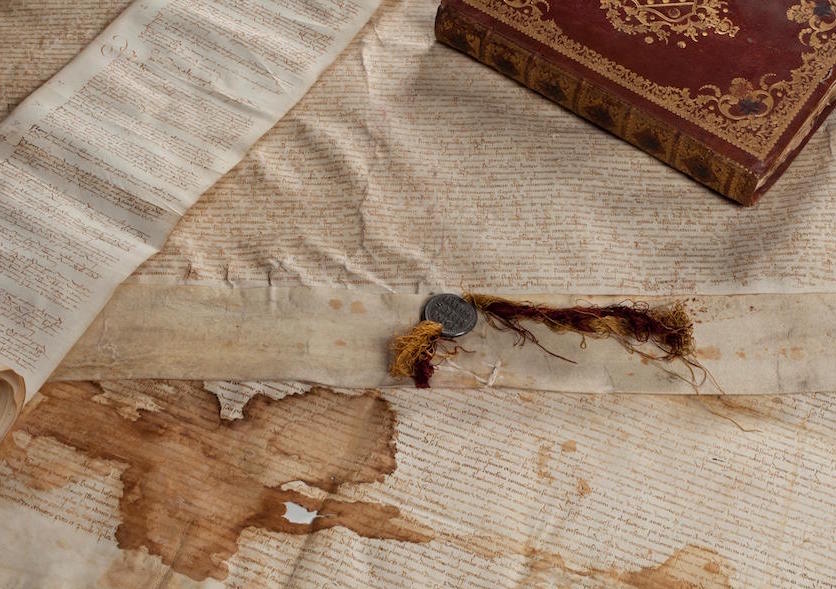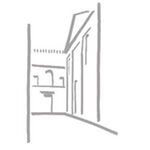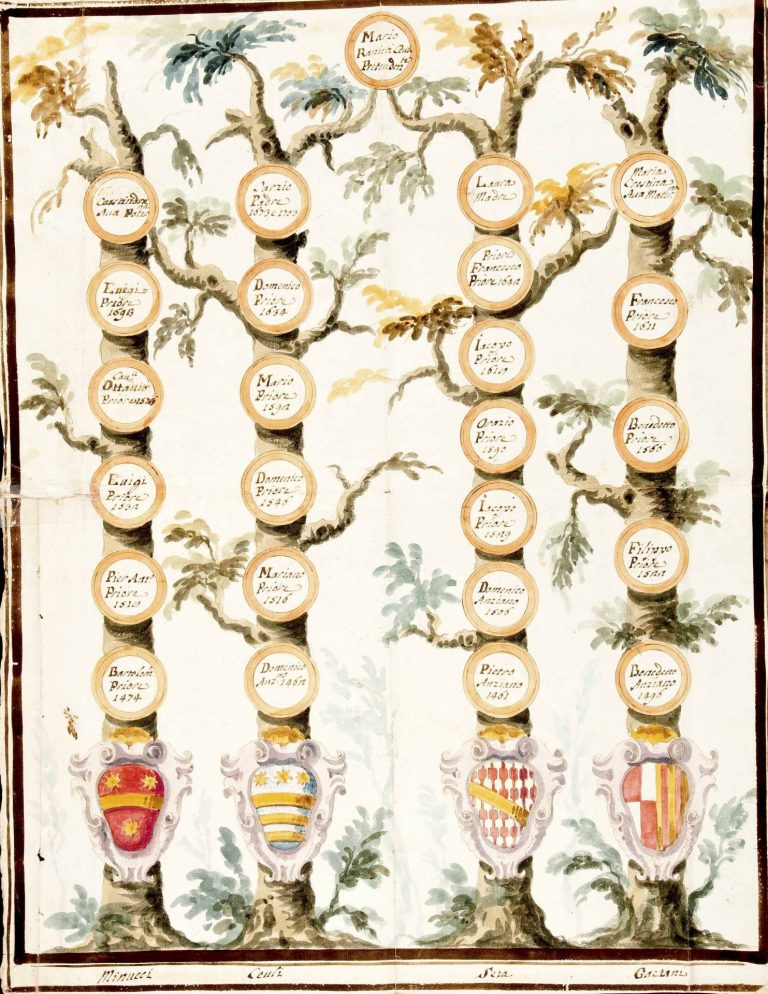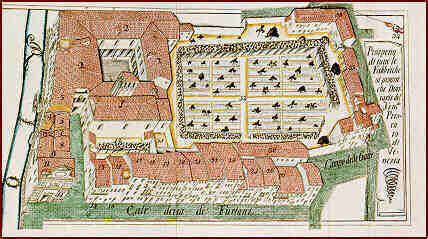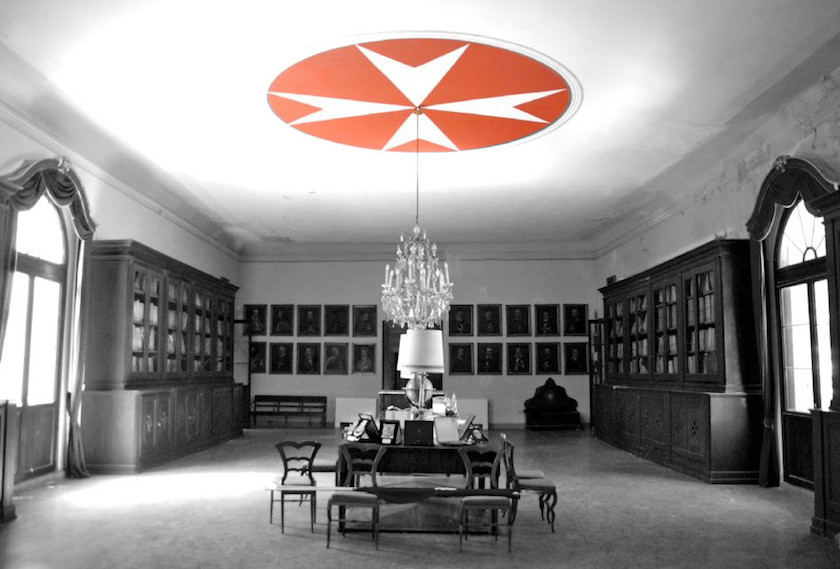
The most important and characteristic room of the building is the archive hall, very large and of solemn appearance. On the walls, in large shelves, were kept the archive of the Grand Priory with documents of great interest, the oldest of which dates back to 1220.
Ranuccio Farnese, nephew of Pope Paul III, Grand Prior of Venice in 1540 and then cardinal, had a list of the archive drawn up in 1549. Fra’ Guglielmo Balbiano da Chieri, Grand Prior, in 1681 ordered the compilation of a new index in two volumes. In 1703 the Grand Prior Fra’ Roberto Solari, of Asti, provided for a new arrangement of the archive, and, discarded the acts not considered necessary, had the documents classified in order of Commende. New rearrangements arranged in 1757 by the Grand Prior Fra’ Antonio Dal Pezzo, of Salerno, and later the Grand Prior Fra’ Francesco Maria Boccadiferro, who entrusted the task to Filippo Vannucchi who carried it out in 1786.
When, in 1806, the Grand Priory was suppressed, the part documents were transferred to the State Archives of the Frari, part withdrawn by the Receiver Commander Fulvio Alfonso Rangone and part by his secretary Donato Antonio Rota Merendis. The Rangone, dying in 1843, left heir the Nobil Homo Filippo Duodo who also had the papers of the archive and entrusted them to the Knight Taddeo Scarella, who represented the Grand Prior Cappellari della Colomba (the Scarella then left some buildings to the Grand Priory, constituting a legacy to meet the costs of worship of the church, a legacy that still exists today).
The documents kept by the Rota Merendis passed, at his death, to his brother Giovanni Maria who entrusted them in deposit to the chaplain Monsignor Pianton, demanding as a reward for the subsequent restitution to be received in the Order as a Donato. Towards the middle of the 19th century arrived at the archive of the Grand Priory of Venice also the papers of the Grand Priory of Lombardy, which were located at the Recipe of Milan (those of the Recipe of Turin ended up in the State Archive of that city).
In fact, the archive of the Milanese Recipe was kept by the Chancellor of that Grand Priory Dr. Antonio Castiglioni until 1831, the year of his death; his widow, Costanza Lavagna, offered them to the Lieutenant of the Grand Master Fra’ Antonio Busca, who resided in Ferrara. But nothing was done, and in 1836 the documents were withdrawn by the representative of the Order in Milan Bailiff Fra’ Cristoforo Ferretti who gave notice to the government, which ordered the delivery to the Chamber magistrate of the part concerning the forfeited goods, and to the Grand Priory in Venice for that matter: so it was done in 1846.
A first summary order of all these papers was given, by order of the Grand Prior Cappellari della Colomba, by Donato Carlo Botti. But the Grand Prior Fra’ Guido Sommi Picenardi was then truly meritorious for having given, between 1884 and 1886, a rational disposition to the archive. The Grand Prior himself later, through patient and tenacious practices, obtained in 1896 the restitution from the State Archives of the Frari of a first group of documents, and in 1903 of everything else, so that the ancient archive of the Grand Priory of Venice could be reunited again at the Palace of Malta.
It is certainly rare and perhaps the only one of the archives of the Priories existing before the devastation of the Napoleonic era that has been preserved and is still in the possession of an organism of the Order. It is rich in important and interesting documents, but unfortunately almost unexplored, at least in its oldest part. The Archive of the Grand Priory is divided into thirty-five classes.
The oldest document dates back to 1220 and is a bull of Pope Honorius III that grants privileges to the Order towards the French bishops; other numerous ancient papal bulls are preserved there, including one of Leo X ratifying an arbitration to settle a question that arose between the Priory of Venice and the nearby Dalmatian School of Saints George and Tryphon.
It is interesting the correspondence relating to a diplomatic incident between the Order and the Venetian Republic in the years after 1670, originated from the fact that Melitensi ships sailing in view of Kythira, an island south of Crete, Venetian possession, having seen some grazing animals at the beach, disembarked and after disarming some guards took possession of it, probably to enrich a little the non-lavish rations on board.
The Legate of the Order in Venice was called to appear before the Doge and the College to hear the complaints, which were transmitted to Malta which responded by declaring itself unaware of the fact. The dispute went on for a long time, a joint commission of inquiry was appointed, composed of admirals; but in the end everything was smoothed out, with mutual declarations of cordiality. Interesting is the ceremonial that regulated the audiences of the melitense legate in the Doge’s Palace; he went there with a procession of gondolas, he sat in the first, gala, golden; others followed with the following, the “negrorîa” and common gondolas. Another ceremonial provided for the formalities for the exchange of visits between the legate of the Order and the other diplomatic representatives accredited to the Serenissima. A report describes the presentation of the credentials of the order’s representative in France to King Louis XIV, with the detailed report of the solemn reception at Versailles.
The class entitled “hospitality” contains papers concerning the ancient Johannine hospital of Santa Caterina in Venice, and similar hospitals in Milan, Rome, Naples and Jerusalem, and the hotel of the Lingua d’Italia in Malta. Of high interest is the content of the class «Armaments, Squad, Trade, Corsairs, Prey and Slaves». From 1282 dates back to the series of papers relating to the Donati, adorned with the octagonal Cross without the upper arm.
At the end of the last century, about 700 heraldic genealogical processes related to Knights received in the Order were calculated, with noble evidence of 2800 families. In recent decades the Archive has been enriched by copies of many trials, the original of which has been transmitted to Rome.
